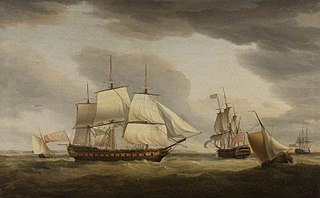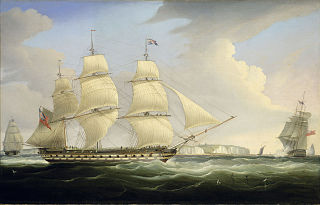
Warley, launched in 1796, was one of the British East India Company's (EIC), larger and more famous East Indiamen. She made nine voyages to the East between 1796 and 1816, most direct to China. In 1804 she participated in the Battle of Pulo Aura. In 1816, the company sold her for breaking up.

Charles Grant was built at Bombay 1810. Between 1810 and 1833 she made 12 voyages as an East Indiaman for the British East India Company (EIC). Her owners sold her in 1834. She then sailed for new owners until 1838 when they had her broken up. Alternatively, she may have been sold to India and burnt there in 1847 at Bombay.
Albion was an East Indiaman of the British East India Company (EIC). She made eight voyages for the EIC before she was sold to the British government in 1810 for service as a troopship. She was lost at sea in 1816.
Perseverance was launched in 1801 as an East Indiaman. She made seven voyages for the British East India Company (EIC), before she was sold in 1819 for breaking up.

Henry Addington was launched in 1800 as an East Indiaman for the British East India Company (EIC). She made seven voyages for the EIC before she was sold in 1815 for breaking up. She was one of the vessels at the Battle of Pulo Aura in 1804.
Wexford was launched in 1802 as an East Indiaman in the service of the British East India Company (EIC). She made seven voyages to India, Persia, and China for the EIC, on the first of which she participated in the battle of Pulo Aura. Her last voyage ended in 1817 and she was broken up c. 1819.
Hope was launched in 1797 on the Thames River. She made seven voyages for the British East India Company (EIC) before she was sold for breaking up in 1816. She was one of the East Indiamen at the battle of Pulo Aura.

Taunton Castle was launched on the River Thames in 1790 as an East Indiaman. She made nine voyages for the British East India Company (EIC) before she was broken up in 1813. In 1797, on her third trip, she was one of a fleet of six East Indiamen that bluffed a squadron of six French frigates into fleeing.
Bridgewater was launched in 1785 as an East Indiaman for the British East India Company (EIC), which engaged her for six voyages. She then made two more as an "extra ship", that is, under voyage charters, and was lost at sea in 1805 while homeward bound from Bombay on her eighth voyage.

Ceres was launched in 1797 as an East Indiaman. She made nine voyages for the British East India Company (EIC), before she was hulked in 1816.

True Briton was launched in 1790 as an East Indiaman for the British East India Company (EIC). She was lost without a trace in 1809 during her eighth voyage.
Nottingham was launched in 1787 as an East Indiaman. She made only eight voyages for the British East India Company (EIC) in the 23 years before she was sold for breaking up.

Winchelsea was launched in 1803 as an East Indiaman for the British East India Company (EIC). She made 11 voyages for the EIC before she was broken up in 1834.

Atlas was launched at Kingston upon Hull in 1812 as an East Indiaman. She made nine voyages to India or China for the British East India Company (EIC) before she was sold in 1831 for breaking up.
Walmer Castle was launched in 1796 as an East Indiaman for the British East India Company (EIC). She made nine voyages for the EIC before she was sold in 1815 to sail as a troopship and supply ship for the British Army. She was broken up in 1821.
Thames was launched on the Thames in 1796 as an East Indiaman. She made eight voyages for the British East India Company (EIC). She was sold for breaking up in 1816.
Essex was launched on 7 February 1803 by Perry, Blackwell as an East Indiaman. She made seven voyages for the British East India Company (EIC) until on 20 August 1821 her register was cancelled as she had been demolished.
David Scott was launched on the Thames in 1801 as an East Indiaman. Between 1801 and 1816 she made seven voyages for the British East India Company (EIC). She was sold in 1816 for hulking.
Marquis of Huntly was launched at Rotherhithe in 1811. She made 11 voyages for the British East India Company (EIC) between 1812 and 1834, when she was broken up.

Castle Huntly was launched at Calcutta in 1812. She then made 11 voyages for the British East India Company as an East Indiaman. After the EIC ceased its shipping business in 1833, new owners continued to sail her between the United Kingdom and China until October 1845 when she was wrecked in the South China Sea.









